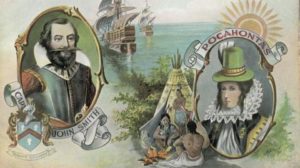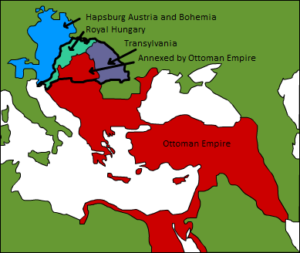Captain John Smith, a Hungarian nobleman
How did the famous Captain John Smith happen to be a member of the Hungarian Valiant Order before he set sail for North America?

Pocahontas must have heard about the siege of Székesfehérvár, Hungary…
I have already written about the deeds of the Scots on the Hungarian battlefields, now it is time to tell you about the heroic adventures of Captain John Smith (1580-1631), the English soldier who later set out for America to meet Pocahontas.
Not many people know that before he visited the New World, he took part in the siege of Székesfehérvár Castle and the capture of Lendva Castle, fought in the army of Lord Székely Mózes and was knighted by the Transylvanian Prince Báthory Zsigmond.
Born in Lincolnshire, England in 1580, he crossed the English Channel at the age of 16 to join the French army. During his early years and travels in Western Europe, he also read the books of Machiavelli, and the ancient philosophers, and learned languages. He became a sailor and sailed the Mediterranean.
He was 20 when he went to Vienna, where he met some imperial officers who told him about the plight of a certain Hungarian fortress that was in great danger because of the wars we now call the 15 Years’ War or the Long War. You can read more about this war here:
https://www.hungarianottomanwars.com/chronologie/the-fifteen-year-war-series-1591-1606/
Smith did not hesitate much, he set out and joined the English officers in the throat of the beast, going to the Hungarian castle in concern.
There he met Count Meldri and General Kisell, who listened to his advice and were able to liberate the castle of Alsólendva:
The castle was surrounded by the Turks, so the reinforcing army could not make contact with the defenders. Captain Smith insisted that he would be able to communicate with the English officers who were in the castle by using torches. Lo and behold, he used the communication signs of the sailors and told his countrymen:
“Gentlemen, we will attack from the east on Thursday night. In the confusion, you sally out.” And so it happened. In addition to this, Smith sent several thousand burning torches to the west side of the castle to confuse the Turks and make them attack in the wrong direction.
After this, Smith stayed in Hungary and began to fight against the Ottomans. He gave some good ideas for the siege of Székesfehérvár, which were welcomed by the leaders, who were none other than Prince Mecoeur, Giorgio Basta, and Archduke Ferdinand. He is said to have invented a new type of hand grenade. Thus Székesfehérvár was recaptured after 50 years of Turkish occupation.
Then Smith joined Count Meldri and went to Transylvania, where the situation was very confusing and it was hard to tell who was with whom at any given time. As Smith had come to like the Hungarians (I wonder if he had learned the language?), he always joined the side where the Hungarians were and fought against the Turks in general. However, there was a time when he fought on the side of Székely Mózes against the Habsburgs and Voivode Mihai Viteazul.

Anyway, his heroic deeds were made while fighting against the Turks: one of his deeds made him a nobleman of Transylvania. It happened that a Turkish envoy challenged the soldiers of the Imperial Army to a duel, telling them that both armies should choose a champion to fight to the death. John Smith was the one who won the duel. However, the Turks repeated the challenge on the next and third days. Our hero also killed his opponents. Smith was officially knighted for this deed in 1602 (see the coat of arms below). He was very proud of his victory and later named a group of islands in Virginia after it: “Three Turk Heads”. We can also see this phrase on his gravestone.

Unfortunately, his success was cut in half when he was injured and captured by the Turks at Vöröstorony. He was sold into slavery, but his Turkish owner’s wife fell in love with him and sent him to her relative at the Caspi Sea. Unfortunately, his life became worse and worse and when they took him to the daily whipping, he killed his owner and ran away to the Russian steppes. There a Russian lady rushed to his aid… Then, after some detours to Hungary and Prague, he returned to England and joined the Virginia Company in 1607. The second part of his life is better known to the world.
As for me, I think he did good service in helping the Hungarians against the Ottomans, and I would remember him as a hero of the Valiant Order of the Borderland.
Dear Readers, I can only make this content available through small donations or by selling my books or T-shirts.
If you like my writings, please feel free to support me with a coffee here:
You can check out my books on Amazon or Draft2Digital, they are available in hardcover, paperback, or ebook:
https://www.amazon.com/dp/198020490X
or at https://books2read.com/b/boYd81


My work can also be followed and supported on Patreon:
















